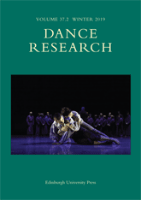
Dance Research
Scope & Guideline
Exploring the Artistry and Impact of Dance
Introduction
Aims and Scopes
- Historical Contextualization of Dance:
The journal frequently addresses the historical evolution of dance forms, examining their socio-political contexts and cultural significances, which helps in understanding contemporary practices. - Interdisciplinary Approaches:
There is a strong emphasis on interdisciplinary research that incorporates perspectives from fields such as anthropology, sociology, performance studies, and cultural studies, enriching the discourse around dance. - Practice as Research:
'Dance Research' encourages the exploration of practice-based methodologies, allowing for the integration of creative practice within academic inquiry, thus bridging the gap between theory and practice. - Cultural Representation and Identity:
The journal often explores themes of cultural identity, representation, and the role of dance in expressing diverse cultural narratives, particularly in the context of globalization and migration. - Impact of Technology on Dance:
Recent publications indicate a growing focus on how technology influences dance creation, performance, and audience engagement, reflecting the evolving landscape of the art form.
Trending and Emerging
- Impact of COVID-19 on Dance Practices:
The pandemic's influence on the dance community is a prominent theme, addressing how artists and institutions have adapted, which provides critical insights into resilience and innovation within the field. - Decolonization and Cultural Heritage:
Emerging discussions focus on the decolonization of dance studies, examining how cultural heritage is preserved and represented, especially in relation to marginalized communities. - Dance and Mental Health:
There is a rising interest in the intersection of dance and mental health, exploring how movement practices can contribute to well-being, particularly in therapeutic contexts. - Dance and Technology Integration:
A growing number of articles are investigating the integration of technology in dance, from virtual performances to digital choreography, highlighting the evolving relationship between dance and modern technology. - Environmental and Social Justice in Dance:
Recent publications are increasingly addressing themes of environmental sustainability and social justice, reflecting a broader societal concern that resonates within the dance community.
Declining or Waning
- Traditional Ballet Studies:
While still significant, there appears to be a decline in papers focused solely on traditional ballet techniques and histories, indicating a shift towards more contemporary and diverse forms of dance. - Eurocentric Perspectives:
There is a noticeable waning of Eurocentric analyses in favor of more global perspectives, suggesting an ongoing effort to decolonize dance studies and embrace a wider array of cultural contexts. - Nostalgic Retrospectives:
Themes centered on nostalgia and historical retrospectives, while still relevant, are seeing less emphasis as the journal moves towards more current and forward-thinking discussions in dance.
Similar Journals
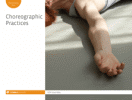
Choreographic Practices
Innovating Choreography, Inspiring PracticeChoreographic Practices is a pioneering journal dedicated to the exploration and analysis of choreography within the field of performing arts, established in 2014 and published by the renowned INTELLECT LTD. As a forum for innovative scholarship, this journal provides a platform for researchers and practitioners to engage in critical discussions regarding the theory and practice of choreography, addressing diverse methodologies and perspectives that shape contemporary dance. Despite its Q4 ranking in the visual and performing arts category, Choreographic Practices aims to enhance the visibility and understanding of choreographic work, allowing contributors to disseminate their findings and artistic practices widely within the academic and artistic communities. Operating from the United Kingdom, the journal serves as an essential resource for scholars, professionals, and students seeking to deepen their knowledge and enhance their practice in the field of choreography.

Quintana-Revista do Departamento de Historia da Arte
Contributing to the Evolution of Artistic UnderstandingQuintana-Revista do Departamento de Historia da Arte, published by the Universidade de Santiago de Compostela, is a distinguished academic journal that focuses on the critical analysis and exploration of visual arts and performing arts. With its ISSN 1579-7414 and E-ISSN 2340-0005, this journal serves as a vital platform for researchers, professionals, and students interested in the depth of art history and cultural discourse. Operating under a Q4 category in the realm of Visual Arts and Performing Arts, the journal is committed to fostering scholarly dialogue and advancing knowledge in the field. Though it currently does not offer open access options, it remains an invaluable resource for those aiming to contribute to and understand the evolving landscape of art history. The journal covers converged years from 2011 to 2012 and 2014 to 2024, highlighting its ongoing relevance and adaptability to contemporary discussions. As it continues to enhance its visibility and impact within the 20th percentile of its category according to Scopus rankings, Quintana invites contributions that deepen our understanding of artistic expression and cultural heritage.

Journal of Mosaic Research
Empowering voices in archaeology and the arts through open access.Journal of Mosaic Research, published by ULUDAG UNIVERSITY, MOSAIC RESEARCH CENTER, is a distinguished open-access journal dedicated to the fields of archaeology, visual arts, and performing arts. Since its establishment in 2019, the journal has been committed to advancing scholarly discourse through innovative research and critical analysis, and it transitioned to an open-access model in 2021 to enhance accessibility and dissemination of knowledge. With an ISSN of 1309-047X, this journal has been recognized for its quality, evidenced by its 2023 rankings which place it in the Q3 quartile for both archaeology and visual arts and performing arts within the Scopus database. Operating from Bursa, Turkey, the journal provides a platform for researchers, professionals, and students to publish their findings, share insights, and engage with contemporary topics in these vital fields of study. As it continues to grow, the Journal of Mosaic Research aims to foster interdisciplinary collaborations and inspire future generations of scholars.
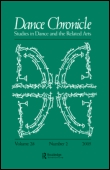
DANCE CHRONICLE
Exploring the Rhythm of Dance ScholarshipDANCE CHRONICLE, an esteemed journal published by Routledge Journals, Taylor & Francis Ltd, serves as a vital platform for the exploration and examination of dance in its multifaceted forms. Established in 1977 and continuing its commitment to the field, this journal engages researchers, professionals, and students alike, providing critical insights into dance history, theory, and contemporary practice. With an impressive track record spanning over four decades, it garners a significant standing within the Visual Arts and Performing Arts categories, evidenced by its Scopus ranking at 282 out of 667, placing it in the 57th percentile. While currently not operating under an open-access model, DANCE CHRONICLE remains an essential resource for those involved in the scholarly analysis and appreciation of dance, making contributions that enrich the cultural and academic dialogues surrounding this dynamic art form.
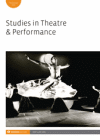
Studies in Theatre and Performance
Fostering Dialogue and Discovery in Theatre StudiesStudies in Theatre and Performance is a distinguished academic journal published by Routledge Journals, Taylor & Francis Ltd, dedicated to advancing scholarship in the dynamic fields of visual arts and performing arts. Since its inception in 2000, the journal has become an essential resource for researchers and professionals, exemplified by its ranking within the Q2 category of visual and performing arts, and its commendable position at the 76th percentile among its peers. With an ISSN of 1468-2761 and an E-ISSN of 2040-0616, the journal serves as a platform for insightful research, critique, and innovation across a variety of topics in theatre and performance studies. Although it operates under a traditional access model, its rigorous peer-review process ensures that every publication contributes significantly to the broader understanding of theatrical practices and performance methodologies. As we move towards 2024, Studies in Theatre and Performance continues to be a vital reference point for scholars and practitioners alike in exploring new dimensions of performance theory and practice in an ever-evolving cultural landscape.
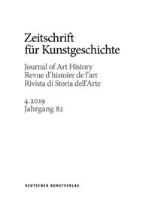
ZEITSCHRIFT FUR KUNSTGESCHICHTE
Exploring the Depths of Art HistoryZEITSCHRIFT FUR KUNSTGESCHICHTE is a prestigious journal dedicated to the study of art history, offering insightful analyses and discussions that enrich the understanding of visual arts and performing arts. Published by DEUTSCHER KUNSTVERLAG GMBH in Germany, this journal has established itself as a significant platform for researchers and professionals alike since its inception. With a print ISSN of 0044-2992 and an e-ISSN of 2569-1619, it spans a comprehensive range of topics in art history, reflecting both traditional and contemporary perspectives. Although categorized in the Q4 quartile for Visual Arts and Performing Arts, the journal contributes to a rich dialogue within its field, aiming to foster academic discourse and promote scholarly research. Its scope has evolved notably from converged years starting in 1975 and gathering strength from 2001 to 2024, and it is committed to serving as an essential resource for students, academics, and practitioners in the arts. While not offering open access, the journal maintains a rigorous peer-review process to ensure high-quality submissions that advance knowledge and stimulate critical thought.
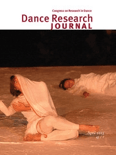
DANCE RESEARCH JOURNAL
Fostering Innovative Dialogues in Dance Studies.DANCE RESEARCH JOURNAL, published by Cambridge University Press, is a premier platform for the exploration and dissemination of scholarly work in the realm of dance studies. Since its inception in 1975, this journal has significantly contributed to the understanding of dance as a vital form of cultural expression and a dynamic art form, holding a commendable position in the Q2 category for Visual Arts and Performing Arts with an impressive Scopus rank of #68 out of 667, placing it in the 89th percentile within its field. The journal features rigorous research articles, critical essays, and groundbreaking studies that foster innovative dialogue among researchers, educators, and practitioners alike. While the journal operates without open access options, its invaluable insights and critical examinations make it an essential resource for anyone seeking to deepen their understanding of dance's multifaceted roles in society. Engage with the DANCE RESEARCH JOURNAL to connect with the latest developments and scholarly conversations that shape the future of dance-related research.

RARITAN-A QUARTERLY REVIEW
Illuminating the Intersections of Culture and ExpressionRARITAN-A QUARTERLY REVIEW is a distinguished academic journal published by RARITAN-A QUARTERLY REVIEW and based in the United States, focusing on the diverse intersections of literature, philosophy, and the visual and performing arts. Operating since 2002, this publication aims to foster critical discourse and enrich the intellectual landscape by showcasing innovative scholarship from a variety of perspectives. Although currently ranked in the fourth quartile in its respective categories—literature and literary theory, philosophy, and visual arts and performing arts—RARITAN remains committed to elevating robust dialogues within the humanities. The journal appeals to a spectrum of scholars, professionals, and students who seek to explore the complexities of cultural and artistic expression. Submissions are encouraged to contribute to the journal’s evolving narrative while adhering to rigorous academic standards. With no open access option currently available, the journal maintains a traditional subscription model, ensuring quality and integrity in the dissemination of knowledge.

Danza e Ricerca-Laboratorio di Studi Scritture Visioni
Unveiling New Perspectives in Dance and Visual StudiesDanza e Ricerca-Laboratorio di Studi Scritture Visioni is a premier academic journal published by UNIV STUDI BOLOGNA, DIPT MUSICA & SPETTACOLO, focusing on the dynamic fields of Visual Arts and Performing Arts. Established in 2002, this Open Access journal has garnered a reputation for fostering scholarly discourse and innovation in the arts. With an ISSN of 2036-1599, it offers a platform for researchers, practitioners, and students to engage with critical analyses, historical explorations, and contemporary practices in dance and visual performance. As of 2023, the journal proudly ranks in the Q3 category for its contributions to the field, with a Scopus rank of #525/667 in Arts and Humanities, indicating its unique position in the academic landscape. Based in Bologna, Italy, the journal not only aims to publish high-quality research but also to enrich the understanding and appreciation of the performing arts in an international context.

PRINT QUARTERLY
Advancing Knowledge in the Arts LandscapePRINT QUARTERLY is a prestigious journal dedicated to the exploration of visual arts and performing arts, published by PRINT QUARTERLY PUBLICATIONS in the United Kingdom. With an ISSN of 0265-8305, this journal has been a pivotal resource since its inception, particularly notable for its diverse range of scholarly articles aimed at both practitioners and academics. Although it does not currently provide open access, PRINT QUARTERLY is indexed in Scopus, ranking #392 out of 584 with a Q3 quartile classification in the 2023 category for Visual Arts and Performing Arts, reflecting its credible contribution to the field. The journal serves as a vital platform for researchers, professionals, and students to engage with contemporary issues, foster academic discourse, and expand understanding of visual and performing arts. As it continues to influence these dynamic disciplines, PRINT QUARTERLY remains an essential resource for those dedicated to the study and practice of the arts.